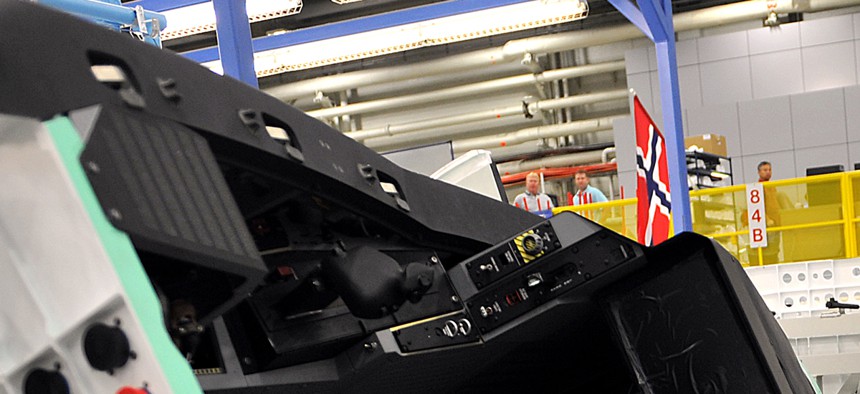
Former Defense Secretary Robert Gates touring an F-35 plant in Fort Worth, Texas DoD photo by Cherie Cullen
Playing the Defense Jobs Card Isn’t Working Anymore
By our count, there are half the F-35 jobs as Lockheed claims. Using defense jobs to fight budget cuts isn’t working like it used to, for good reason. By William D. Hartung
The history of Pentagon spending is rife with examples in which programs have been saved from the budget cutter’s axe because of the jobs associated with them. From the revival of the B-1 bomber in the 1980s to the current effort to keep the M-1 tank line open, jobs in key states and districts have provided powerful leverage to contractors seeking to save or extend major procurement programs. But those days may be coming to an end.
For the past two and one-half years, the Aerospace Industries Association, or AIA, has repeatedly played the jobs card in an effort to spare the Pentagon budget from automatic cuts called for in 2011’s Budget Control Act. The association sponsored studies claiming that a million jobs would be eliminated if sequester level cuts took effect at the Pentagon, and spread the word far and wide. But despite the partial reprieve supplied by December’s budget agreement, the bulk of the cuts called for by the Budget Control Act are taking effect and the widespread economic damage claimed by the AIA has not occurred. The jobs card didn’t work, and the massive job losses never materialized.
Even if the jobs argument didn’t save the Pentagon top line from reductions, it can still play a role in determining the future of specific weapons systems. The determination of the Congress to continue funding for programs like the M-1 tank and the Global Hawk is evidence that job-driven pork barrel politics is a alive and well. But even in fights over specific programs, the jobs argument isn’t as powerful as it used to be.
(Read more Defense One coverage on the budget here)
The termination of the F-22 combat aircraft -- known as the Raptor -- is a case in point. When the Pentagon decided to end the program at 187 planes, Lockheed Martin and its partners on the project claimed that the program was supporting 95,000 jobs in 44 states. Over 200 members of the House, 44 Senators, 12 governors and the leadership of the International Association of Machinists sent “Save the Raptor” letters to the president, emphasizing the jobs argument. But when the showdown vote came in the Senate, a bipartisan anti-F-22 coalition led by Senate Armed Services Committee leaders Sens. Carl Levin, D-Mich., and John McCain, R-Ariz., carried the day. While liberal Democrats like Patty Murray, D-Wash., Dianne Feinstein, D-Calif., and Barbara Boxer, D-Calif. -- with significant F-22 work in their states -- voted for the program, their votes were offset by Republican budget hawks like Sens. Jim DeMint, R-S.C., John Ensign, R-Nev., and Mike Enzi, R-Utah, who voted against the F-22. The jobs argument failed.
A similar logic played out when Congress finally ended General Electric’s bid to be a second engine supplier for the F-35 combat aircraft. A bipartisan effort led by Rep. Tom Rooney, R-Fla., ended the second engine program despite the fact that the work would have been done near fellow Republican House Speaker John Boehner’s Ohio district.
The F-35 is the latest big project that is being touted as a major jobs creator as a way to fend off critics and ensure a steady flow of funding. But if the program is to be fully funded, it may have to win on the merits, not by emphasizing how many jobs it could create.
In a new report by the Center for International Policy, we have found that Lockheed Martin has exaggerated the number of jobs associated with the F-35 by a factor of two. In addition, the jobs generated by the program will be much more concentrated than F-35 boosters would have us believe, with over half of the jobs in just two states, Texas and California. And large portions of the aircraft will be built overseas.
In short, there just aren’t enough F-35 jobs in enough key locations to make the jobs argument a decisive factor in funding decisions about the plane. If the F-35 is to be fully funded, the contractors and the Air Force will have to prove that the planes can overcome current, serious cost and performance problems, and that they are needed to address the most urgent 21st century threats. Given that the F-35 is slated to be the most expensive weapons program ever undertaken by the Pentagon, that could be a hard sell. And if recent history is any indication, making exaggerated claims about the jobs the F-35 program will create won’t be much help in making the case for the plane.
William D. Hartung is the director of the Arms and Security Project at the Center for International Policy and the author of a new report, “Promising the Sky: Pork Barrel Politics and the F-35.”



